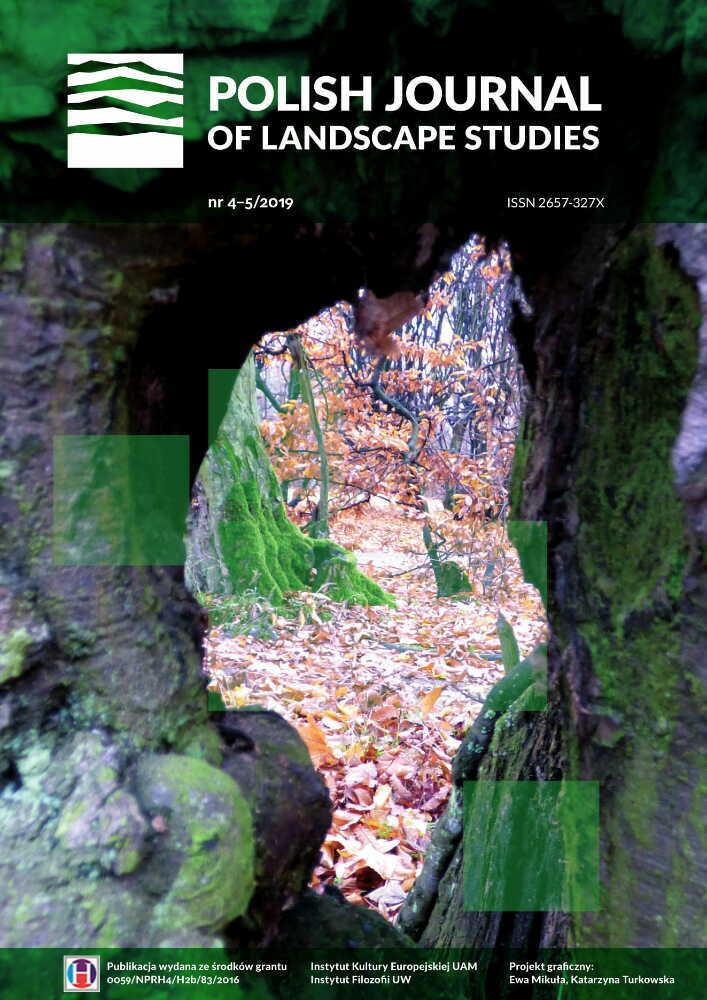Abstrakt
The author analyzes Karolina Grzywnowicz’s installation Weeds (2015): a meadow which the artist replanted from two villages in Bieszczady—whose inhabitants had been resettled in 1944-1950—into a site adjoining a street in Warsaw. The meadow was promptly mowed by the municipal services, and thus became a twofold commemoration. First, it was a deliberately created yet subtle and poetical monument to the displaced people. Second, in a manner unanticipated by the artist, it grew into a symbolic martyrdom memorial of the “green urban anarchists”: weeds in other words. The author analyzes the relationships between non-human lives and history, asking whether the marginal history of plants is ever noticed in scientific and social reflection, as well as wondering about the role of plants in commemoration and why they fail as a medium of memory.Bibliografia
Assmann, Aleida. 2010. “Canon and Archive. In A companion to cultural memory studies”, edited by Astrid Erll, Ansgar Nünning, 97—108. Berlin: de Gruyter.
Assmann, Aleida. 2013. “Pamięć miejsc — autentyzm i upamiętnianie” [“The Memory of Place— Authenticity and Commemoration”]. Translated by Justyna Górny. In Między historią a pamięcią. Antologia [Between History and Memory: Anthology], edited by Magdalena Saryusz-Wolska, 168—89. Warsaw: WUW.
Bagiński, Arek and Andrzej Jóźwicki. n.d. O nowoczesności i zagładzie [On Modernity and Extermination]. http://industrialart.eu/teksty/wywiad-nowoczesnosc-i-zaglada. Accessed April 14, 2017
Bakke, Monika. 2011. “Postnaturalna historia Edunii” [“A Post-Natural History of Edunia”]. Kultura Współczesna 1: 116—24.
Baratay, Éric. 2012. “Le point de vue animal. Une autre version de l’histoire”, Paris: Seuil.
Bodnar, John. 1992. Remaking America: Public Memory, Commemoration, and Patriotism in the Twentieth Century. Princeton: Princeton University Press.
Burnett, Frances Hodgson. 1911. The Secret Garden. New York: Frederick A. Stokes Co.
Chamovitz, Daniel. 2012. What a Plant Knows: A Field Guide To The Senses Of Your Garden - And Beyond. New York: New Farrar, Straus and Giroux.
Clément, Gilles. n.d. The Third Landscape. http://www.gillesclement.com/art-454-tit-The-Third-Landscape. Accessed April 14, 2017.
Dłużewska, Emilia. 2016. “Warszawa. Instalacja artystyczna “Chwasty” skoszona przez kosiarkę” [“Warsaw. Artistic Installation “Weeds” Mowed]. Gazeta Wyborcza, August 2.
Domań ska, Ewa. 2010. “Jakiej metodologii potrzebuje współczesna humanistyka?” [“What Kind of Methodology do the Contemporary Humanities Need?”]. Teksty Drugie 1/2: 45—55.
Domańska, Ewa. 2017. “Przestrzenie Zagłady w perspektywie ekologiczno-nekrologicznej” [“Post-Holocaust Spaces in an Ecological-Necrological Perspective”]. Teksty Drugie 2: 34—61.
Gancarz, Natalia. 2011. “Pierwszy figuralny Pomnik Pamięci o Zagładzie Romów” [“The First Figural Memorial to the Roma Victims of the Genocide”]. Studia Romologica 4: 267—70.
Gieba, Kamila. 2017. “Dyslokacja przestrzeni, dysfunkcja tożsamości. Elementy kontr-dyskursu w polskiej literaturze migracyjnej (1945-1989)” [“Dislocation of Space, Dysfunction of Identity: Elements of Counter-Discourse in Polish Migrant Literature (1945—1989)”]. In Migracyjna pamięć, wspólnota, tożsamość [Migrant Memory, Community, Identity], edited by Ryszard Nycz, Tomasz Sapota, Roma Sendyka, 206—24. Warsaw: Wydawnictwo Instytut Badań Literackich PAN.
Grzywnowicz, Karolina. n.d. http://chwasty.com/o-projekcie/. Accessed April 14, 2017.
Hall, Matthew. 2011. Plants as Persons. A Philosophical Botany. New York: State University of New York Press.
Jeśman, Joanna. 2015. Żywa Sztuka. Wielowymiarowość bioartu w kontekście posthumanistycznym [Living Art: Multidimensionality of Bioart in a Post-Humanist Context]. Warsaw: Wydawnictwo Akademickie Sedno.
Kac, Eduardo. 2010. “Bio Art: Od Genesis do Natural History of Enigma” [“Bio Art: From Genesis to the Natural History of Enigma”]. Translated by Mariola Sułkowska-Janowska. Folia Philosophica 28: 13—37.
Kuryłowicz, Beata. 2012. Semantyka nazw kwiatów w poezji Młodej Polski [Semantics of Plant Names in Young Poland Poetry]. Białystok: Wydawnictwo Uniwersytetu w Białymstoku.
Leśmian, Bolesław. 1920. Łąka [Meadow]. Kraków: J. Mortkowicz.
Marx, Karl. 1932. Capital: A Critique of Political Economy. Translated by Samuel Moore and Edward Aveling, New York: Random House Inc.
Morstin, Ludwik Hieronim. 1909. Psalm ziemi, Chwasty kwitnące na rodzajnym polu. Poezye [Earth Psalm: Weeds in Flower on a Fertile Field; Poems]. Kraków.
Mościcki, Paweł. n.d. http://chwasty.com. Accessed April 14, 2017.
Nijakowski, Lech M. 2006. Domeny symboliczne. Konflikty narodowe i etniczne w wymiarze symbolicznym [Symbolic Domains: National and Ethnic Conflicts in the Symbolic Dimension]. Warsaw: Wydawnictwo Naukowe Scholar.
Ostrowski, Marek, Barbara Sudnik-Wójcikowska, and Halina Galera. 2008. “I oczom odkrywców ukazała się zielona wyspa… Badanie botaniczne na Stadionie” [“And the Discoverers’ Eyes Saw a Green Island… Botanic Research at the Stadium”]. In Stadion X. Miejsce, którego nie było. Reader [Stadium X: A Place that Never Was; A reader], edited by Joanna Warsza, 98—101. Warsaw: Korporacja Ha!art, Bęc Zmiana.
Pietrasik, Agata. 2010. Przekraczając monumentalność — projekty pomnika w Birkenau. [Beyond Monumentality — projects for the Birkenau Monument]. http://archiwum-obieg.u-jazdowski.pl/teksty/17949,29.06.2010. Accessed April 17, 2017.
Pisulewski, Szymon. 1845. Botanika popularna obejmująca opisanie drzew, krzewów i roślin zielonych tak krajowych, jak i zagranicznych, szczególnych swemi własnościami i history, tudzież mających zastosowanie w przemyśle, sztukach, rzemiosłach, gospodarstwie domowem i wiejskiem [Popular Botany Comprising the Description of Trees, Shrubs and Green Plants Both Domestic and Foreign, Peculiar in Their Qualities and History, as well Having Use in Industry, Arts, Crafts, Household and Farm]. Warsaw.
Sendyka, Roma. 2017. “Nie-miejsca pamięci i ich nie-ludzkie pomniki” [“Non-Places of Memory and Their Non-Human Monuments”]. Teksty Drugie 2: 86—109.
Smith, Neil. 2002. “New Globalism, New Urbanism: Gentrification as Global Urban Strategy.” Antipode 34: 427—50.
Smith, Neil. 2008. Uneven Development: Nature, Capital and the Production of Space. Athens, Georgia: University of Georgia Press.
Smith, Neil. 2000. “What happened to class?” Environment and Planning A 32: 1011—32.
Springer, Filip. 2011. Miedzianka. Historia znikania [Miedzianka: A History of Disappearing]. Wołowiec: Wydawnictwo Czarne.
Szelburg-Zarembina, Ewa. 1972. “Ogród króla Marcina” [“King Martin’s Garden”]. In Królestwo Bajki [Fairy tale kingdom], 231—336. Warsaw: Nasza Księgarnia.
Wrocenter. n.d. http://grun.wrocenter.pl/o-projekcie/. Accessed April 14, 2017.
Zuziak, Zbigniew K. 2007. “Ekologiczne definiowanie urbanistyki” [“Ecological Approach to Town Planning”]. Czasopismo Techniczne z. 7-A: 9—20.
